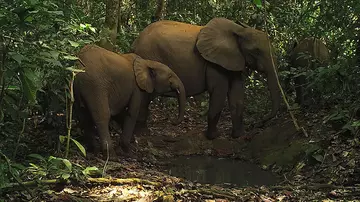
ZSL
Zoological Society of London
ZSL monitoring & technology programme manager Dr. Anthony Dancer reveals how Google Cloud AI is supporting ZSL’s conservation work in Cameroon in surprising ways…
Protected areas are the cornerstone of global nature conservation efforts , but are extraordinarily hard to protect. They’re generally situated in remote and inaccessible locations and are often enormous in size, which makes monitoring what’s going on in them particularly challenging.
But tracking how species are faring - and, critically, what threats they are facing - is an essential prerequisite to understanding how they can be effectively conserved, so the ZSL monitoring & technology team is always looking for new and improved solutions to aid our work.
Conservationists have historically turned to camera traps to overcome these challenges – hardy, battery-powered, automatic cameras, triggered by the movement of animals and people.

Camera traps have been revolutionary for the field of wildlife conservation and continue to be key to protected area management. Indeed, improving camera trapping methods and increasing their utility for conservation has always been a key focus for ZSL’s monitoring & technology team, from developing satellite connected cameras that send images from protected areas in real time - a ZSL system named Instant Detect - to contributing to global platforms for cutting edge analysis of camera trap data.
More recently, the ZSL team began exploring the potential for acoustic technology to increase our monitoring capacity. Where camera traps are restricted to providing information from the narrow window in front of their lenses and only as far as you can see (which is not very far in tropical forests), acoustic sensors can capture sound through 360 degrees, recording events happening hundreds of metres away – we knew that if this potential could be harnessed it would open the door to cheap, efficient, broadscale monitoring throughout protected areas.
With this in mind, in 2018, with funding from the Shuttleworth Foundation and with support from the Arribada Initiative, ZSL deployed an array of tiny, innovative, low-cost acoustic loggers – called AudioMoths – throughout the northern sector of the Dja Faunal Reserve in Cameroon. We wanted to listen out for the species that were present, including African forest elephants and western lowland gorillas, and to improve our understanding of if and how human activity, including armed poaching, was threatening them.

But analysing thousands of hours of recordings presented a new challenge – one that ZSL, in collaboration with researchers at Imperial College, turned to Google Cloud to explore.
Working with Google Cloud’s support we set about creating a pipeline for analysing the acoustic data, using the power of AI, which you can read about for the first time here:
Now that we have a rapid, efficient way to process acoustic information, the next step is to deploy the technology at scale throughout protected areas, and to feed results back to park staff and rangers so they can better protect the animals in their care. We’re excited about the impact this innovation will have on ZSL’s global conservation and beyond.
Climate change and human activity have pushed our precious planet to its limit, causing the devastating loss of so many habitats and species. From lab to field, hands on and behind the scenes, we’re leading the future of conservation, shaping agendas and influencing change to support better life, health and living for people and wildlife.
